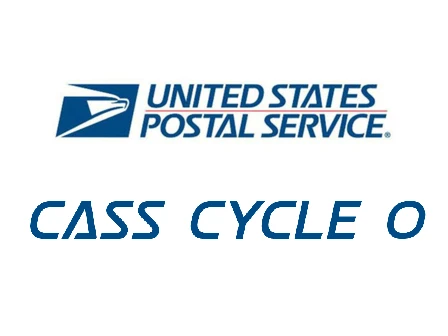USPS CASS Cycle O: A comprehensive guide

USPS CASS Cycle O is the USPS's foundational system for ensuring the accuracy and precision of address validation. CASS stands for Coding Accuracy Support System and is the rulebook that dictates how addresses should be processed, matched, and validated. Taking effect August 1, 2023, Cycle O is the latest chapter in this rulebook, bringing a slew of updates and changes.
The primary objective of Cycle O is to refine the address-matching process, making it even more accurate and efficient. The new cycle is a critical update for mailers as it directly impacts address processing and validation, ensuring that mail reaches its intended recipient without hiccups.
Historically, the USPS published cycle updates every two years. However, the previous version, CASS, Cycle N, went live on August 1, 2011. With 12 years since the last cycle change, many updates are long overdue.
| US Address Verification | International Address Verification | Find out about our CASS certification |
|---|---|---|
In this article, we'll cover:
- Critical changes in Cass Cycle O
- Benefits of Cass Cycle O
- Adjusting your systems, processes, & software for Cycle O
- What's next
Critical changes in CASS Cycle O
The postal service is introducing several pivotal changes in Cycle O, including:
- Reference data: The foundational data used for address matching was updated, ensuring the system works with the most current and accurate information.
- Matching sogic: The algorithms and logic behind address matching are refined, leading to more precise results.
- New address fields: Specialized address types, which were previously not recognized, now have their dedicated fields, ensuring they're processed correctly.
- Lengthened fields: The addressee, delivery line 1, delivery line 2, and last line have all increased from varchar(50) have extended to varchar(64).
Detailed changes
- DPV and DSF flags: These were updated to provide more detailed information about address deliverability.
- DPV codes: These codes provide insights into address validation and have been clarified. New details include whether or not a secondary number, like an apartment or unit number, is required for an entered address and details about whether address components get omitted to find the match.
- Footnotes: Definitions and explanations are redefined for better clarity.
- New features: Exciting features like PO Box™ Only Delivery Zones and 5-Digit ZIP Validation have been introduced, further refining the address validation process.
For more details, see our Cycle O docs page. We'd also suggest reading the USPS CASS Cycle O Executive Summary for more details.

Benefits of CASS Cycle O
With these Cycle O updates, the USPS is seeking to:
- Promote address quality
- Reduce undeliverable mail
- Ease implementation, use, & understanding
- Make changes that benefit mailers, the USPS, and recipients
The introduction of Cycle O isn't just a technical update; it brings a plethora of benefits:
- Address quality: With the refined systems, the quality of address validation will see a marked improvement, drastically reducing undeliverable mail.
- Simplicity: The new standards make the system more user-friendly for mailers, the USPS, and recipients.
- Cost savings: By adhering to the new standards, businesses can avail of postal discounts, leading to significant savings.
- Accuracy: The chances of undeliverable and misdelivered mailpieces are reduced, thanks to the improved accuracy of address validation.
Adjusting your systems, processes, & software for CASS Cycle O
Adapting to Cycle O may require some preparation from your organization to understand the changes and the new data elements that Cycle O introduces.
Software development changes
- Software update: Ensure your software is updated to align with the Cycle O technical standards
- Documentation: Review all relevant documentation to understand the changes.
- Training: Ensure your teams are trained and familiar with the new standards.
- Processes: Adjust your business processes to incorporate the changes.
- Testing: Before full-scale implementation, conduct rigorous testing.
- Performance: Monitor the performance to ensure optimal results.
- Vendor communication: Stay in touch with your software vendors for continuous updates and support.
You can also use a USPS CASS Certified address validation software, like Smarty™.
Potential pitfalls
Like any significant change, there are potential pitfalls with Cycle O, such as:
- Unpreparedness: Unprepared businesses may miss out on postal discounts, leading to increased costs.
- Reduced address data quality: There's a reduced address information quality risk if the new standards aren't appropriately implemented.
We suggest gaining an understanding of the changes and new data introduced with Cycle O. If address data quality is vital to your organization, it's crucial to connect all departments, from technical to operational, and ensure everyone is on the same page. Understanding industry regulations and updating systems can make the transition smoother.
While USPS Cycle O's is immediately associated with address validation, shipping, and mail delivery, the implications of accurate address data stretch far beyond mailability.
Here's how companies in various industries should consider adapting to the Cycle O update:
Database management and system updates
Field adjustments: With changes in address field lengths, companies should review and possibly modify their database fields to ensure they can accommodate the new lengthened data structures.

Data cleaning: It's an opportune time for businesses to clean up their databases, removing outdated addresses and ensuring the new ones adhere to Cycle O standards.
Billing and invoicing: For companies that send out regular bills or invoices, ensuring address accuracy can reduce the number of returned mail and improve cash flow.
Marketing campaigns: Direct mail campaigns, promotional offers, or even simple newsletters must reach the right audience. With the Cycle O update, marketing teams can better target their audience, ensuring higher ROI on campaigns.
Fraud detection: Accurate address validation can be a tool for detecting and preventing fraudulent activities. For instance, a mismatch in address data can be a red flag in sectors like banking or ecommerce.
Regulatory compliance: Maintaining accurate address records is crucial, especially for sectors like finance and healthcare, where regulatory compliance is stringent.
Profile creation: For online platforms or apps where users create profiles, guiding them with address suggestions based on Cycle O can enhance user experience.
Feedback and surveys: Companies often send out feedback forms or surveys. Ensuring these reach the intended recipient can provide companies with valuable insights.
Resource allocation: Accurate address data can help in efficient route planning and resource allocation for businesses with field operations, like service or maintenance visits.
Inventory management: Retailers with brick-and-mortar stores can use accurate address data to understand customer demographics better, aiding in inventory decisions.
Market analysis: Companies can use address data to analyze market penetration, understand regional preferences, and plan expansion strategies.
Mergers and acquisitions: For businesses considering mergers or acquisitions, accurate address data of customers, suppliers, or partners can provide insights into geographical strengths and gaps.
Essentially, the Cycle O update isn't just a postal service refinement; it's an opportunity for businesses to introspect, refine, and enhance their operations. Address data, often overlooked, can be a goldmine of insights and efficiencies waiting to be tapped.
What's next
CASS Cycle O is a significant milestone in USPS address validation. Its introduction promises more accuracy, efficiency, and cost savings. As we move towards this new era, mailers and businesses must understand, adapt, and make the most of these changes. The future of mailing is here, and it's more exciting than ever. Smarty has incorporated these changes into our address validation. Try it out for yourself.